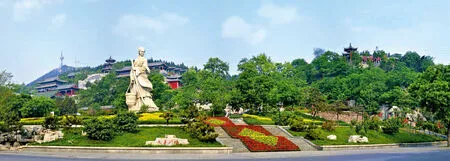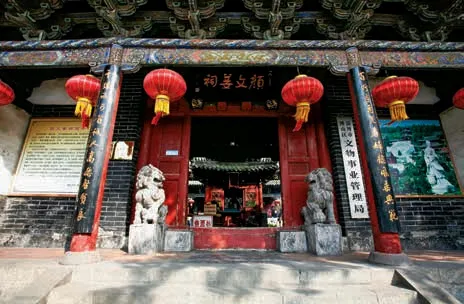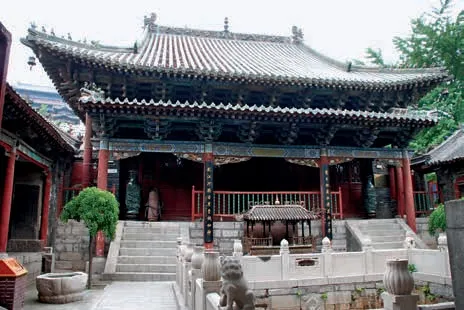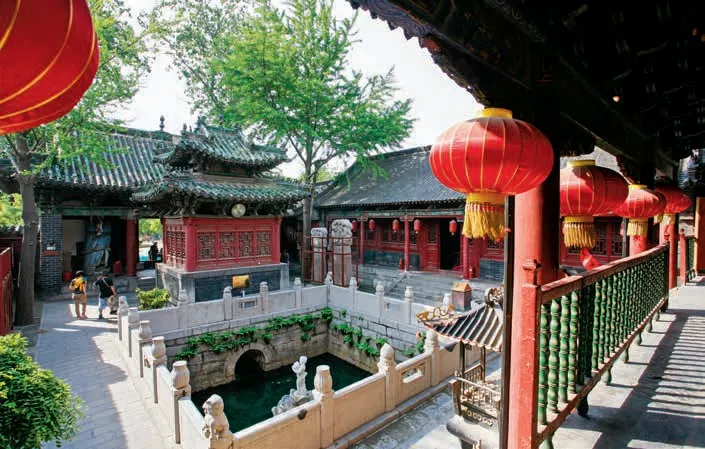大唐遗风颜文姜祠
2022-06-06魏伟李生军穆若信
文/魏伟 李生军 穆若信

颜文姜雕像与古祠相得益彰,是博山的标志性建筑。图/马新生The Statue of Yan Wenjiang and the old temple add radiance to each other,and are landmark buildings of Boshan.
感天动地颜文姜
博山古称颜神,因颜文姜而得名。清乾隆十八年《博山县志》载:“周末,齐国西南郊长城岭下之北鄙,有孝妇颜文姜居岭下,殁而有神,故后世目其地为颜神。”
东晋郭缘生的《述征记》,是最早记述颜文姜事迹的古籍。书载:“齐有孝妇颜文姜,事姑至孝,远道取水,不以寒暑易心,感得灵泉生于室内,文姜常以缉笼盖之。姑怪其需水即得,值姜不在,入室发笼观之,水即喷涌成河,坏其居宅。”后世如郦道元《水经注》、顾野王《舆地志》、李冗《独异志》、乐史《太平寰宇记》、于钦《齐乘》等书中,都记载了颜文姜的故事,并不断增加神话色彩,使颜文姜孝顺公婆的形象更加完善。
颜文姜因感天动地的故事而被人们神化,当地人将其尊称为“颜神”,并为其立庙建祠,这就是颜文姜祠的由来。据史书记载,颜文姜祠初建时当是简陋的草庙或石庙,较大规模的修建始于唐代天宝五年(746年),先起建正殿及山门,其余均为后来所建。北宋咸平六年(1003年),因颜神之祠“属以年祀浸远,祠宇久隳”而进行过修葺,熙宁六年(1073年)进一步增修。因宋神宗敕封颜文姜为“顺德夫人”,故颜文姜祠又被称作“顺德夫人祠”。元代,颜文姜被封为“卫国夫人”,影响力丝毫不减。
明代弘治八年(1495年),颜文姜祠内又复建了寝殿、两庑、香亭、门左右翼,规制愈加宏敞。清代顺治十四年(1657年)九月,当地耆宿孙廷铨、赵班玺主持维修正殿时,看到大殿四面皆为木雕槅扇,恐年久侵损,遂以砖石将大殿两侧及后墙改为石基砖砌加固,并增减殿前券廊,使大殿更加壮观,富有神采。

颜文姜祠为全国重点文物保护单位。图/翁伟The Yan Wenjiang Temple is a key national heritage conservation unit.
世所罕见唐建筑
颜文姜祠的主体建筑,名曰“正殿”,俗称“无梁大殿”,是祠内最具历史价值的建筑。
更建于唐代天宝五年的正殿今年已1276岁“高龄”,高15米,宽13米,长17米,飞檐斗拱,十分壮观。正殿建成后,经历代修葺,“容貌”发生变化,尤其是清初正殿出现倾斜,房屋被加固和局部修整,使其外观上呈现明清式建筑的“假象”。直到2001年,经几位古建筑专家鉴定,其悬鱼博风板、石雕柱础、斗拱角梁、柱网布设都显示出典型的唐代建筑特征。
由于木构架建筑容易风化腐朽,因而存世极少。此前,中国仅有五台山的南禅寺和佛光寺两处建筑被认定为唐代木构架建筑,在它们被发现之前,建筑学界一度认为中国的唐代木构架建筑只能在日本看到。
颜文姜祠正殿建筑构造独特精巧,利用四根斜柱同时向上支撑于一根龙形雷公柱中,雷公柱上放置八角形放射状斗拱,用以承托屋脊与屋面的重量,斜柱下方分别置于四根金柱之上,并通过金柱将力传至地基。这种无梁设计,在有限的高度腾出了较大的空间,注重结构安全实用性和艺术性的结合,向人们展示了古人不凡的智慧和高超的技艺。
支撑正殿屋顶的斗拱,采用了将角科斗拱和相邻的平身科斗拱连为一体的方法,称为“鸳鸯交手拱”,十分罕见。这种斗拱可使大殿屋面出檐更加深远,而且能够承托起巨大的屋面翼角,充分显示了唐代建筑大气华贵的独特风格。


更建于唐代天宝五年(746年)的正殿,迄今已有1276年历史。图/中共博山区委宣传部提供Rebuilt in the fifth year of the Tianbao Period of Tang (746 AD),the Main Hall has a history of 1,276 years.
传承千载孝文化
经过历代修葺、扩建,除正殿外,目前的颜文姜祠还有山门、香亭、寝殿、土地祠等建筑,共83间房,建筑面积1368.34平方米。

香亭后面的泉叫“灵泉”,乃孝妇河源头之一,泉眼在大殿下面的涵洞里。泉水从涵洞流出,经博山、淄川、张店,绕周村,入桓台马踏湖。灵泉四时不竭,象征孝文化世代传承,故颜文姜祠又名“灵泉庙”。颜文姜祠内还保存有许多珍贵的石碑,内容多为表彰颜文姜孝行感天、德配天地的高尚品质。
颜文姜祠建筑群体现了中国古代优秀的建筑法式,被认为是中国古代建筑史上的一个伟大创举。更为重要的是,颜文姜以一介平民而受到历代统治阶级的尊崇,反映了中国人自古以来对“孝”的重视。
为弘扬华夏孝文化,突出博山地域文化特色,2002年,当地在颜文姜祠北侧辟建了1.2万平方米的文姜广场。高达17米的大理石颜文姜汲水雕像,耸立在凤凰山东麓,古祠和雕像相得益彰,成为博山标志性建筑物和闪亮名片。2006年,颜文姜祠扩建暨孝园建设工程完工,为千年古祠铸就了新的丰碑,同年,颜文姜祠被国务院批准为全国重点文物保护单位。
博山历代守护着这座古祠,守护着这座精神家园。

香亭与灵泉位于颜文姜祠建筑群的中轴线上。图/翁伟Xiangting (Pavilion) and Lingquan (Spring) are located on the central axis of the Yan Wenjiang Temple building complex.
At the foot of the Fenghuang Mountain in the southwestern suburb of Boshan District,Zibo,there is a time-honored classical building complex in a strong national style.It is the Yan Wenjiang Temple,a key national heritage conservation unit.The temple was built in the Northern Zhou Dynasty,and rebuilt in the Tang Dynasty.After expansion and addition in Song,Yuan and Qing Dynasties,it has a typical Tang Dynasty wooden frame architectural style and is the largest existing ancient building complex in Zibo City.For thousands of years,the temple and the story of the obedient woman Yan Wenjiang have become the valuable cultural heritage for inheriting the local filial piety culture.
The main building of the temple,named “Main Hall”,commonly known as “Beamless Hall”,is the most historically valuable building in the temple.Built in the fifth year of the Tianbao Period of Tang,the Main Hall is 1,276 years old now,with a height of 15 m,a width of 13 m and a length of 17 m.Its cornices and bucket arches appear vibrant.Pan Rongshen,a famous ancient architecture expert,after careful research on the hall,once wrote a special article saying that its architectural structure is unique and exquisite,which is very rare in China,and can be called “one of the best ancient buildings” in China.
The Yan Wenjiang Temple building complex reflects the excellent building mode of ancient China,and is deemed as a great stage in ancient Chinese building history.More importantly,as an ordinary person,Yan Wenjiang was revered by the ruling class of past dynasties.This reflects that the Chinese people have attached importance to “filial piety” since ancient times.
To carry forward the China’s filial piety culture and highlight Boshan’s regional culture characteristics,the local government built the Wenjiang Square (12,000 m) on the north of the temple in 2002.The 17-meter-high marble statue of Yan Wenjiang Fetching Water stands at the eastern foot of the Fenghuang Mountain.The temple and the statue add radiance to each other,and become landmark buildings and shining image icons of Boshan.
